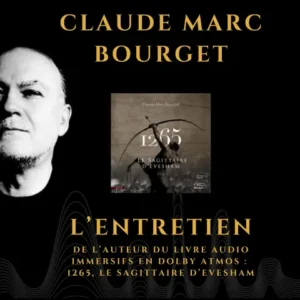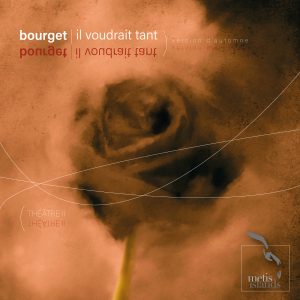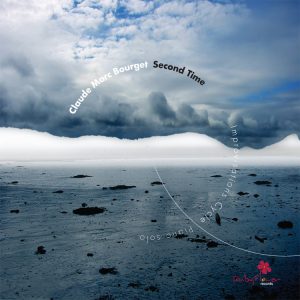Interview / 1265. Le Sagittaire d’Evesham (livre audio) sur Le Blog du livre audio (France)
Interview / 1265. Le Sagittaire d’Evesham (livre audio) sur Radio VM
Écoutez l’interview sur le Sagittaire d’Evesham à Radio VM.
 QUESTIONS D’ACTUALITÉ (Radio VM, Montréal) :
QUESTIONS D’ACTUALITÉ (Radio VM, Montréal) :
Philippe Labrecque reçoit Claude Marc Bourget. Émission en direct du 22 août 2025.
Ou lisez la transcription de l’interview à Radio VM (PDF).
Il voudrait tant, version d’automne / Presse
Claude-Marc Bourget dévoile une nouvelle version de « Il voudrait tant »
« Une oeuvre inhabituelle, unique, qui ramène aux univers de Brel, Ferré, Barbara. »
Métis Islands Records vient de sortir une nouvelle version de « Il voudrait tant », chanson initialement présente sur l’album « Les amants de l’ombre », sur un texte écrit en collaboration avec la romancière Sarah Vajda.
Pianiste et compositeur, Claude Marc Bourget a fait paraître, au cours de sa carrière, des albums instrumentaux qui ont suscité les éloges de la critique internationale, certains évoquant une filiation avec des maîtres comme Debussy, Ravel ou encore Stravinsky.
Cette nouvelle version, nommée version d’automne, fait plus de 11 minutes. Durée inhabituelle pour une oeuvre inhabituelle, unique, qui ramène aux univers de Brel, Ferré, Barbara.
Après avoir pris le parti de la chanson française et fait entendre sa voix avec « Les amants de l’ombre », son premier opus chanté, il persiste et signe avec cette nouvelle version de l’un des textes clé de l’album, où s’exprime de plus en plus fortement son univers théâtral dans une manière unique d’aborder la chanson.
Distribués par Select, « Les amants de l’ombre » et la nouvelle version de « Il voudrait tant » sont offerts sur support physique et en format numérique.
Source : https://qfq.com/spip.php?article70406&debut_dossier_10DerniersArticles=2040
Interview / Les Amants de l’ombre
« Un moment de grâce »
«Six chansons qui demandent à être découvertes… avec mille et une tendresses». «Les amants de l’ombre, un disque sur lequel on retrouve six chansons qui demandent une attention, un moment de grâce lors de l’écoute. » Raymond Desmarteau, Radio-Canada International
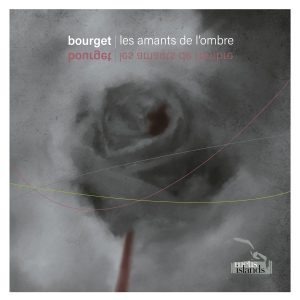
![]()
Voir article complet sur Radio-Canada International.
 Audio : Écoutez l’entretien de Bourget
Audio : Écoutez l’entretien de Bourget
avec Raymond Desmarteau sur l’album Les Amants de l’ombre.
Écoutez l’album. Disponibles sur toutes plates-formes numériques en tous pays,
LivretCRITIQUE — Le Mystère Des Trois Jours from Claude Marc Bourget
Album Review: Le Mystère Des Trois Jours from Claude Marc Bourget
Christ’s Resurrection Set to Virtual Violins and Piano
May 25, 2014
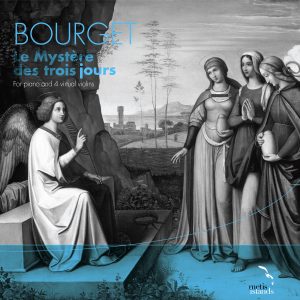 Le Mystère des Trois Jours (The Mystery of the Three Days) from Claude Marc Bourget is a 3-track CD that showcases Bourget’s prowess as a masterful pianist and programmer of virtual violins in addition to being an effective narrator. His compositions have an ambient coloring with choral-tinged passages that pervade a Gothic tint. Each composition represents a specific movement, telling the story of Christ’s resurrection through music. « Premier Jour » (First Day) symbolizes Christ’s death. « Deuxième Jour » (Second Day) reflects the transformation process. The last track « Troisième Jour » (Third Day) characterizes Christ’s resurrection. Inspired by the Biblical story, the music shows reverence for the miracle and provides sonic vignettes depicting the three stages of the evolution.
Le Mystère des Trois Jours (The Mystery of the Three Days) from Claude Marc Bourget is a 3-track CD that showcases Bourget’s prowess as a masterful pianist and programmer of virtual violins in addition to being an effective narrator. His compositions have an ambient coloring with choral-tinged passages that pervade a Gothic tint. Each composition represents a specific movement, telling the story of Christ’s resurrection through music. « Premier Jour » (First Day) symbolizes Christ’s death. « Deuxième Jour » (Second Day) reflects the transformation process. The last track « Troisième Jour » (Third Day) characterizes Christ’s resurrection. Inspired by the Biblical story, the music shows reverence for the miracle and provides sonic vignettes depicting the three stages of the evolution.CRITIQUE — NOVIAUS TANZ FROM CLAUDE MARC BOURGET
5/14/12 REVIEW
JAZZ TIMES, USA, by Susan Frances
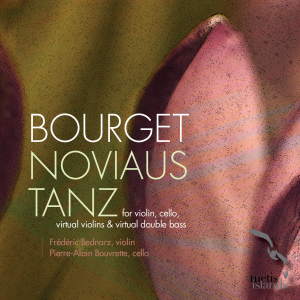 NOVIAUS TANZ review (extract)
NOVIAUS TANZ review (extract)
Classical pianist Claude Marc Bourget plays a new role on his latest recording Noviaus Tanz from Metis Islands Production as a programmer and arranger of the virtual violin and virtual double bass. Coupling electronic music with the acoustic ethers of cellist Pierre Alain Bouvrette and violinist Frederic Bednarz, Bourget creates elevating raptures and extemporaneous ripples that focus the mind and stimulate calmness through the soul.
The harmonies are melodically organized and arranged to flow with a natural elegance. Silky textured strings open “Ferments” coiled in winding cello rings. The verses roam with a vivacious spontaneity projecting orchestral arcs spruced by branches of improvisational sprigs. The broad, hushed strokes of “Cadences” alternate between light and heavy pressured notes while the crisp stride of “Signes” is garnished in ballerina-like twirls, lifts and jetes. The instruments transmute a lead and follow scheme which seduces the listener to move along with the established pattern.
Noviaus Tanz is innovative music with a dichotomy of electronic and acoustic sounds molding them into electrifying compositions. The improvised swags and curves add to the pieces majesty and allude to a sonic plane beyond the temporal world.
Critique / Pilgrim of the Strings ⎯ Chassé
JAZZ TIMES, USA, by Susan Frances
PILGRIM OF THE STRINGS
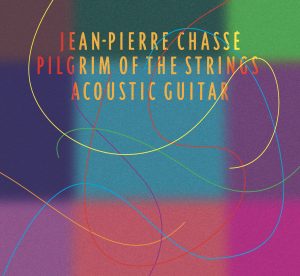 Pilgrim of the Strings, the new recording from acoustic guitarist Jean-Pierre Chassé is a lush embroidery of ambient soundscapes tooled in penetrating improvisations, protracting arpeggios and melodic fractals. The Montreal native teamed up with classical pianist Claude Marc Bourget who produced the recording while mixed and mastered by Jacques Laurin. A synthesis of flamenco, bossa nova and ambient jazz, Pilgrim of the Strings soars with a nimble imagination reflective of vintage Django Reinhardt and the melodic sensibilties of Paco.
Pilgrim of the Strings, the new recording from acoustic guitarist Jean-Pierre Chassé is a lush embroidery of ambient soundscapes tooled in penetrating improvisations, protracting arpeggios and melodic fractals. The Montreal native teamed up with classical pianist Claude Marc Bourget who produced the recording while mixed and mastered by Jacques Laurin. A synthesis of flamenco, bossa nova and ambient jazz, Pilgrim of the Strings soars with a nimble imagination reflective of vintage Django Reinhardt and the melodic sensibilties of Paco.
The soft, angelic sonorous of « Passage To Europe » contrasts the rattling chords swagging « Lo Mas Importante es Vivir.» The elegant flamenco wings of « The Other Side of Eyes » move with a dancer’s instinct switching to the taut arpeggios of « Narmada Ka Pani » highlighting sizzling, erotic chord rotations which are embellished by Turkish accents. The gentle acoustic twirls and spinning riffs of « Pas a Pas » complement the whispery tendrils of « Ishindenshinun » ascending and descending along the melodic scale creating a storytelling voicing in the chord expressions creased by a Spanish flare. The graceful gait of the chord scheme along « Los Ultimos Pajaros » is propelled by sprinting chord patterns and sleek improvisations that retract and soar trajecting intermittantly. The bossa nova stylizing of « Atoll das Rocas » changes to a bop-inspired rhythm in « Bop’s Memories » reminiscent of the gypsy tones of Django Reinhardt and the bluesy entwines of Richard Hart.
Jean-Pierre Chassé is a one of kind guitarist. His sense of melodic phrasing and timing for penetrative improvisations puts him in the ilk of Paco. His tracks weave into each other without disruption moving with the ease of the Alps flowing across the borders of Frances, Switzerland and Italy. Motivated by passion, Pilgrim of the Strings gives definition to ambient jazz with comfy atmospherics that allude to evenings cruising along the Mediterranean. (JazzTimes) / Read the review by Susan Frances.
20/05/12 REVIEW, par Nicolas Pelletier
BLOGUE EN MUSIQUE, Québec
LE VIRTUOSE JEAN-PIERRE CHASSÉ SE DISTINGUE
 Trop souvent, les musiciens comme le guitariste Jean-Pierre Chassé passent inaperçus. La musique qu’ils émettent n’est simplement pas assez sexy, pas assez pop, pas assez prévisible pour que le grand public s’y intéresse. Les médias aussi, nous avons notre part de responsabilité dans ce manque de visibilité. Exposer des talents tels celui de Jean-Pierre Chassé ne « rapporte » pas autant qu’un (autre) potin sur une chanteuse R’n’b qui dévoile un peu plus de poitrine que le mois dernier.
Trop souvent, les musiciens comme le guitariste Jean-Pierre Chassé passent inaperçus. La musique qu’ils émettent n’est simplement pas assez sexy, pas assez pop, pas assez prévisible pour que le grand public s’y intéresse. Les médias aussi, nous avons notre part de responsabilité dans ce manque de visibilité. Exposer des talents tels celui de Jean-Pierre Chassé ne « rapporte » pas autant qu’un (autre) potin sur une chanteuse R’n’b qui dévoile un peu plus de poitrine que le mois dernier.
Je vous invite ce matin à prendre une pause de tout cela et de prendre le temps d’apprécier la superbe musique de ce guitariste extraordinaire qu’est Jean-Pierre Chassé. Aussi habile dans un style classique contemporain que le flamenco ou le tango (Los mass importante es vivir), ce Montréalais de 56 ans n’a rien à envier aux Steve Howe (Yes) de ce monde. Son style varie entre jazz et classique et est teinté de plusieurs influences. On pourrait dire qu’il se cherche. On pourrait aussi dire qu’il se distingue.Alors qu’aujourd’hui, il est si facile de programmer des échantillonnages pour monter un groove accrocheur, on oublie trop vite qu’il doit exister des virtuoses instrumentaux pour créer des passages dignes d’être repris. Le nouveau disque de Chassé est bien plus que des passages, c’est un superbe recueil de neuf pièces instrumentales qui font vibrer la guitare classique de façon spectaculaire. Chassé peut jouer la carte de la virtuosité technique puis celui de la sensibilité dans le phrasé suivant. Comme tout grand musicien, Jean-Pierre Chassé sait laisser sonner chaque note. Il comprend le rôle de chacune: sur The Other Side of Eyes, la mélodie est en avant-plan, solide, alors que des fioritures passent leur chemin plus loin derrière, à un autre niveau.
Oui, vraiment, Jean-Pierre Chassé est un musicien d’un autre niveau. Les mélomanes ouverts aux styles musicaux les plus variés sauront le reconnaître dès les premiers instants.
(Blogue en musique) / Lire la critique par Nicolas Pelletier.
Critiques / Musiques de ballet
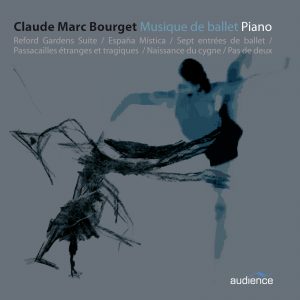 JAZZ INSIDE MAGAZINE, New York
JAZZ INSIDE MAGAZINE, New York
Interview
Making Beautiful Music With Just Two Hands. “For me, playing the piano is black and white photography applied to music. It is the orchestra in equation. Everything is there, but at the principle level, behind the image, like roots under the flowers. I love black and white in photography. The piano with its black and white keys immediately gives the sign of its economy. In that sense, only the string quartet would approach it. The jazz trio too, belongs to this pure world. Other trinity, other mystery,”
ASSOCIATED CONTENT, ARTS & ENTERTAINMENT
« Musiques de Ballet is a phenomenal endeavor which gels multiple expressions, textures and dynamics that bend and reflect capriciously, and subsequently inject meaning into Bourget’s art. »
JAZZ INSIDE MAGAZINE, New-York
Pianist Claude Marc Bourget can orchestrate energizing symphonies with the nimble movements of his ten fingers across the keys of a grand piano. The protégé of such arduous musicians as Chopin, Debussy, Stravinsky, Paul Bley, and Keith Jarrett, Bourget has a heart that is true to his passionate nature and a mind that exhibits a boundless imagination. (…) Like his predecessors, Claude Marc Bourget is not trapped into becoming a period pianist but a musician whose improvisations will be relevant for centuries to come. His synthesis of jazz and classical music structures is inspiring and positions him to become a source of motivation for aspiring musicians to come.
Critiques / Second Time
(…) Second Time, realizzato in perfetta solitudine su uno Steinway gran coda (suono magnifico!), si sviluppa infatti come un lungo racconto, come una lunga suite. Preceduta da un cappello introduttivo, la prima parte si muove lungo le coordinate « consuete » del piano solo in chiave jazz. Gli inevitabili echi jarrettiani, dunque. Ma assai più forte, in Bourget, è l’impronta del conterraneo Paul Bley. L’amore per la risoluzione inattesa, per il cambio d’umore che, nello spazio di una nota, ci porta da un gioioso maggiore ad una malinconia più intima.
Con lo scorrere delle tracce si insinuano qua e là, fino a diventare predominanti, gli echi classici. Non solo dal punto di vista compositivo (Brahms e Beethoven, cuore della seconda parte), ma anche da quello esecutivo. La mano sinistra, spesso trascurata dai pianisti jazz, svolge qui un lavoro enorme diventando a tratti la vera protagonista. ⎯ Paolo Peviani
JAZZ TIMES, USA
Bourget creates a balance between the deposits of rage and peacefulness in nature. His compositions channel the moods which guide nature’s course, and draws out its beauty even when confronted with its darker, brooding tirades. Second Time demonstrates Bourget’s agility as a pianist, and skillfulness to convey nature’s messages to audiences. He shows a desire for challenges, and a need to master them. ⎯ Susan Frances
JAZZ REVIEW, USA
« The intensity of the music and the quality of the recording pull you into the music, until you feel almost as if you are sitting alone in a concert hall. (…) No matter whether you are solo piano aficionado or not, Bourget’s sound is enthralling. His technical and creative facilities alone are admirable, but the sheer intensity of his music is enough to draw the most callused listener in. When so much music follows set forms of conformity and repeating phrases, it’s easy to get lost in the long, full themes that seem to never end. I am not traditionally a fan of solo piano works, and I probably won’t go out and buy any right away, but this album will definitely have a spot in my listening library. » ⎯ Lorelei Clarke
JAZZ REVIEW, USA
“ Bourget’s compositions are strictly focused as well as free to soar as high as the creative imagination will allow and sink as low as the heart’s emotional abyss. Through the episodes of deep contemplation and mesmerizing flights, Bourget exhibits impressive maturity that causes people to stop in their tracks and listen to him. (…) His long stretches of wanderings wicked by the piano keys seem mysteriously guided, as even the moments of transgressions manage to stay on course like they are under a trance, which stops them from trailing away from their objective, and every track resounds with an objective in mind. (…) His album Second Time shows his skills as a virtuoso on the piano, but also as a masterful composer and arranger. At 52 years of age, Bourget does not seem to want to turn back time, but to move ahead with it, as Second Time embraces huge challenges and tests Bourget’s reflexes to move spontaneously along the changing tides.” ⎯ Susan Frances
JAZZ FRISSON, CANADA
« Bourget est un pianiste exigeant. Introspectif par moment, plus exubérant sur certains morceaux, il nous fait vivre toute une gamme d’émotions. Il faut se laisser envelopper par sa musique, dont l’émotion se dévoile par couches successives comme l’aube naissante révèle les détails qui nous entourent. La musique de Bourget est majestueuse, vecteur de tous les chagrins, joies et espoirs qui y transitent sereinement. » ⎯ Jazz Frisson).
THE LIVE MUSIC REPORT, CANADA
Bourget “explore a mysterious and vast territory. A great gust of wind blowing the melodies against a wall of sound”. (Live Music Report) . / Read the full review byJessica Lombardi.
Entretien / Claude Marc Bourget improvise Montréal
JAZZ FRISSON, Montréal (2007)

Jazz Frisson / Claude Marc, je note en lisant ta bio, que l’année 1983 fut très fertile pour toi. Puis, une soudaine absence de la scène musicale jusqu’à l’année dernière. Qu’est-ce qui explique une si longue absence, considérant ce début si prometteur? Et qu’est-ce qui motive ton retour à la scène musicale après 20 ans d’arrêt ?
Cmb / Je dirais que cette explosion même fut en un sens la raison de cette rupture, ou du moins son explication. Par rapport aux années de rêve ou d’espoir qui préparent le musicien à la scène, car la musique tend naturellement à l’auditoire et n’est pour soi seul, en somme, qu’une écriture sans voix, cette flambée de 1983 m’avait à la fois comblé et déçu. J’étais comblé du fait que s’exprimait et était soudain écouté ce qui depuis des années avait besoin de l’être, qui d’ailleurs n’était pas toujours de la musique (un certain sport des sons, dirais-je), mais qui parfois en fut : une musique du temps, dans un temps qui était au fracas, à la quête du danger sonore, à une expérimentation totale dont nos devanciers d’après-guerre avaient donné l’exemple et le feu de départ, aussi bien en musique contemporaine qu’en free jazz.
Mais, arrivé au port, après le voyage, je fus déçu. Rien ne m’y attendait. Le but avait été le voyage comme tel et ses grandes vagues, pas plus. La destination était vide, comme une paralysie dans l’éther par l’attraction de l’ivresse. Il me fallait réfléchir, repartir de l’origine, reprendre tout le chemin. Je le fis par la littérature, la philosophie, un peu à l’abri de la musique, quoique faisant mes gammes, si l’on veut, comme à vide. Vingt ans de livres et d’écoute. Je suis maintenant prêt à continuer. Vingt années ne sont rien devant les millénaires, l’éternité de la musique.
JF / L’improvisation en piano solo est sans doute l’une des disciplines les plus exigeantes qui soit. Tu sembles avoir une inspiration inépuisable! Quelles sont tes sources d’inspirations?
Cmb / Ce que j’affectionne tout d’abord dans l’improvisation au piano seul, c’est la pureté du geste, loin des machines à composer et à décomposer, des effets faciles et vendus par leurs noms, parfois en solde, dans les épiceries à musique. L’art du piano, du récital, du solo, possède sa noble histoire, son aventure qui continue, toujours humaine, alimentée du legs des grands et des petits artistes et comme au-dessus de l’abrutissement électronique. Je n’y vois d’équivalent, de nos jours, que la boxe. Le pur moment du face à face réel et sans filet, devant nos frères humains, concentrés, affamés de choses humaines et parfois divines, si j’ose dire. Mes sources d’inspiration, en ce sens, sont mes prédécesseurs dans l’art du piano, jazz et classique, mais non moins la musique en entier, pour peu qu’on puisse la circonscrire, elle que je tente de faire entrer en synthèse dans mon petit coin du monde.
JF / Tu es autodidacte. Quels musiciens furent essentiels dans ton apprentissage, en tant que modèles?
Cmb / Ils sont nombreux. Côté compositeurs, l’impressionniste Debussy, Stravinsky le pragmatique, le métaphysique Schoenberg pour le XXe siècle. Guillaume de Machaut pour le XIVe siècle, à la suite de Pérotin et de Léonin, à l’École de Paris ou de Notre-Dame, l’un des summums de la civilisation musicale. Sinon, pour le piano et l’orchestre, Beethoven, à l’orée du romantisme, malgré son obsession prométhéenne, sans oublier Bach le très grand maître et Mozart l’illuminé, surtout pour ses messes. Puis, en matière de jazz, Monk, Davis, Mingus, le Canadien Bley et le regretté Steve Lacy, les vieux sages de ce temps. Mais si je sépare ici le jazz du «classique», c’est par habitude et commodité, car la musique en tant que telle, ni par ses créateurs ni par ses auditoires, ne se divise si facilement. Entre le jazz, né vers les années 1910, et les Debussy, Stravinsky, Satie, Hindemith, qui dans le même temps donnaient une nouvelle Europe musicale, il y a davantage d’affinités que de dissemblances.
Côté interprètes, Horowitz, qui fit à Rachmaninov arrêter le piano et qui toujours m’étourdit, mais pour idéal personnel le sobre et fort William Kempf, dont je n’arriverai jamais à suivre l’indicible retenu, le maintien supérieur, le dosage esprit-matière, la musicalité chevaleresque et silencieuse, finalement, sans accentuation mielleuse ni maniérisme. Hors piano, Davis en jazz et Billie Holiday, la reine absolue, la Callas du jazz, celle que nous apportons sur l’île déserte, en attendant la fin des temps. Ajoutons Cecil Taylor le soliste, grand libérateur physique et charnel, mais après qui il faut revenir et panser les plaies vives de l’animalité, je veux dire de la primauté des instincts.
JF / Ton site, www.claudemarcbourget.com, s’enrichit de nouvelles improvisations régulièrement. Quelle est ta méthode de travail pour maintenir ce rythme?
Cmb/ Le pari du site, pas toujours tenu mais que je souhaite gagner, c’est de présenter au jour le jour, c’est-à-dire selon son rythme vrai, l’évolution de mon travail, un peu comme si l’on me suivait en concert, dans une tournée d’improvisations que j’espère d’ailleurs réaliser, si on m’en donne la chance. L’improvisation, ce sont finalement des variations de thèmes ou de chants, d’harmonies, de dessins ou de motifs, de styles et même de techniques et doigtés, qui mises ensemble nous servent de route où, par la correction, l’amendement, la curiosité et l’attention physique et intellectuelle, nous nous transformons nous-mêmes à chaque étape et tournant. La méthode est donc liée à l’idée même de variations, et c’est de celles-ci, de par leur nature, que naît l’impression d’abondance.
JF / Quel est le souvenir le plus mémorable de ta carrière de musicien?
Cmb / J’allais dire mon arrêt et aujourd’hui, surtout, mon retour, car le moment dont tu parles, je crois qu’il reste à venir. Je retiens tout de même Erdro Erdrosed II, au Musée d’art contemporain de Montréal, où l’on m’a donné tous les moyens d’expérimenter certains chemins alors jamais empruntés de l’improvisation musicale, en ce que les instrumentistes, enregistrés live et à qui les magnétophones redonnait subséquemment leur musique, rejouaient sur scène avec eux-mêmes, selon bien sûr des schémas d’ordonnancement et des méthodes les protégeant contre toute espèce de fusion insensée et de capharnaüm sonore. J’ajouterais mon passage comme soliste au Festival de Jazz de Montréal, dont j’ai malheureusement perdu les bandes. J’avais donné ce soir-là, m’avait-on dit alors, ma meilleure prestation. C’est sans doute un signe et une très bonne chose que d’en avoir perdu trace. Le souvenir est souvent plus fort que l’enregistrement, et même plus juste et authentique, en un sens, car il n’y a pas de microphone, de piste, d’appareil pour retenir les anges.
JF / Est-ce qu’il y des projets d’album ou de concert prévus pour 2007?
Cmb / Je connais pour l’instant mon purgatoire, que j’assume très bien, notamment à l’aide de mon site. À cinquante ans, entre deux âges, nos projets et nos œuvres sont des projets et des œuvres de la maturité, les premiers aboutissements de nous-mêmes. La chose doit se refléter dans nos collaborations. Je mets la barre haute dans mes exigences, mais ça commence à porter fruit. J’avais calculé une année de prospection et de «publicité» pour mon retour. J’en suis à 6 mois et ça ressemble au plan. J’aurai bientôt de fort bonnes nouvelles du côté album solo, ce que j’aimerais d’abord entreprendre. Ensuite seulement viendront les concerts, sauf exceptions. Mais pendant tout ce temps, j’alimenterai mon site. D’autre part, je parle d’improvisations, mais je compose également. Sur la table un concerto pour piano, où le pianiste devra improviser sur une musique écrite à l’orchestre, puis une messe en l’honneur de Notre-Dame et un opéra dont j’écris le livret à partir de mes notes pour un roman sur un héros de notre histoire, mais aussi une figure universelle, Le Moyne d’Iberville. Je ne chôme pas.
JF / En dehors de la musique, quelles sont tes plus grandes passions?
Cmb / La littérature, bien entendu, l’histoire et la politique. Mais je me repose de tout cela, et la musique est mon refuge, mon choix. Je ne suis jamais plus heureux qu’y travaillant, sinon auprès des miens et de mes amis chers. Je me dois d’ajouter le design graphique, qui me permet en outre de gagner ma vie sans autre concession.
JF / Toutes catégories confondues, quelle est la musique, ou les albums, que tu écoutes actuellement (à la maison ou sur ton iPod)?
Cmb / Jamais d’iPod, question de ne pas tuer les oreilles, qui comme les hommes meurent par où elles ont péché. Mais j’écoute et réécoute Stravinsky, celui d’après le Sacre du printemps (1913), c’est-à-dire le Stravinsky des semences et de la continuité, celui dont le 20e siècle a raté l’héritage et auquel il faut revenir. Le Sacre consommait la rupture. On a commis l’erreur d’y voir un nouveau chemin, alors qu’il fermait les livres d’une époque, la menait à son comble dans une sorte de fureur cérébrale. La grande leçon stravinskienne, qui est une leçon positive, une école de création et de foi, non de nihilisme et de désespoir, vient après, avec tous les caractères de la continuité séminale, c’est-à-dire de la tradition sans cesse réinventée. C’est d’ailleurs ce que fais le jazz, qui toujours est resté vivant, à côté d’un classicisme stérilisé par son immobilisme et son fétichisme de l’écrit. Le jazz, plus près du verbe, n’a pas raté sa perpétuation, et ses enfants sont magnifiques et pleins de santé. Il mérite de grands égards. L’essentiel est de ne pas l’emprisonner à son tour. C’est ce que je cherche humblement à faire.
JF / L’année 2007 risque d’être très fructueuse pour toi, avec tous les projets en cours. Quel est ton plus grand rêve à long terme, musicalement?
Cmb / Celui de tout musicien, je crois. Celui de mener à terme mes projets, avec un public pour les recevoir, les comprendre et peut-être les aimer, celui d’aller au bout de l’exercice, de parfaire la musique et sa communication, c’est-à-dire de se perfectionner soi-même par cette espèce d’affrontement périlleux et bienfaisant qu’est la prestation, en concert ou en enregistrement, qui consiste à demander l’attention et donc d’en être digne.
